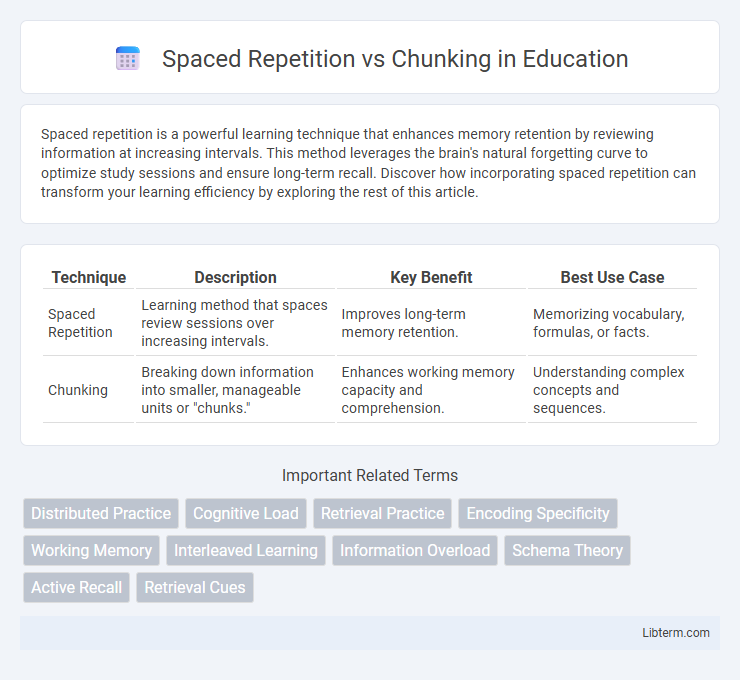Spaced repetition is a powerful learning technique that enhances memory retention by reviewing information at increasing intervals. This method leverages the brain's natural forgetting curve to optimize study sessions and ensure long-term recall. Discover how incorporating spaced repetition can transform your learning efficiency by exploring the rest of this article.
Table of Comparison
| Technique | Description | Key Benefit | Best Use Case |
|---|---|---|---|
| Spaced Repetition | Learning method that spaces review sessions over increasing intervals. | Improves long-term memory retention. | Memorizing vocabulary, formulas, or facts. |
| Chunking | Breaking down information into smaller, manageable units or "chunks." | Enhances working memory capacity and comprehension. | Understanding complex concepts and sequences. |
Introduction to Memory Techniques
Spaced repetition enhances long-term memory retention by distributing study sessions over increasing intervals, effectively combating forgetting curves. Chunking, on the other hand, improves working memory capacity by grouping information into meaningful units, facilitating easier recall. Both techniques leverage cognitive principles to optimize learning efficiency and information retention in educational and professional contexts.
What is Spaced Repetition?
Spaced repetition is a learning technique that involves reviewing information at increasing intervals to enhance long-term memory retention. This method leverages the psychological spacing effect, which improves recall by spacing out study sessions rather than massed practice. Research in cognitive psychology shows that spaced repetition significantly boosts retention compared to cramming or continuous study.
Understanding Chunking
Chunking enhances learning by grouping individual pieces of information into meaningful units, improving memory retention and cognitive processing. This technique leverages the brain's ability to recognize patterns, making complex data more manageable and easier to recall. Understanding chunking is essential for optimizing study strategies, especially when combined with spaced repetition for long-term knowledge retention.
Cognitive Science Behind Spaced Repetition
Spaced repetition leverages the brain's natural memory consolidation process by distributing learning sessions over increasing intervals, which strengthens long-term retention and counters the forgetting curve. Cognitive science reveals that this method enhances synaptic plasticity, making neural connections more durable through repeated, spaced exposure to information. In contrast to chunking, which organizes data into manageable units, spaced repetition specifically targets memory reinforcement timing to optimize recall efficiency.
The Psychology of Chunking
Chunking leverages the brain's capacity to group information into meaningful units, enhancing memory retention by reducing cognitive load. This psychological process improves learning efficiency by organizing disparate elements into coherent patterns, facilitating easier retrieval from working memory. Research shows that chunking engages neural pathways associated with pattern recognition and long-term memory consolidation, making it a powerful tool for mastering complex information.
Key Differences Between Spaced Repetition and Chunking
Spaced repetition leverages timed intervals to reinforce memory retention, optimizing long-term recall by revisiting information at strategically increasing gaps. Chunking organizes data into manageable units or "chunks," enhancing working memory capacity and simplifying complex information processing. The key difference lies in spaced repetition's temporal approach to strengthen memory over time, whereas chunking focuses on structuring information for immediate cognitive ease.
Benefits and Limitations of Spaced Repetition
Spaced repetition enhances long-term memory retention by systematically increasing intervals between review sessions, effectively counteracting the forgetting curve through repeated exposure to information. This method benefits learners by promoting durable memory consolidation and efficient use of study time, yet it requires consistent scheduling and may not be as effective for understanding complex concepts without supplementary techniques. Limitations include potential difficulty in initial setup and the challenge of applying spaced repetition to information that demands deep comprehension rather than rote memorization.
Advantages and Drawbacks of Chunking
Chunking enhances memory retention by organizing information into manageable units, making complex material easier to understand and recall, particularly in subjects like language learning and mathematics. However, chunking can become ineffective if the chunks are too large or poorly structured, leading to cognitive overload and difficulty in applying the information. Unlike spaced repetition, which optimizes long-term retention through intervals, chunking primarily improves immediate comprehension and initial encoding of information.
When to Use Spaced Repetition vs Chunking
Spaced repetition is most effective for memorizing detailed information over time, such as vocabulary, formulas, or historical dates, by reinforcing knowledge at increasing intervals. Chunking is ideal for understanding and retaining complex data by grouping related elements into manageable units, useful in learning phone numbers, concepts, or steps in a process. Use spaced repetition for long-term retention of discrete facts and chunking when organizing information into meaningful patterns enhances comprehension and recall.
Integrating Both Methods for Optimal Learning
Integrating spaced repetition and chunking enhances memory retention by combining the benefits of interval-based review with manageable information units. Breaking complex material into meaningful chunks allows the brain to process and store data efficiently, while spaced repetition schedules repeated exposure at optimal intervals, reinforcing long-term retention. This dual approach leverages cognitive psychology principles, maximizing learning efficiency and reducing cognitive overload during study sessions.
Spaced Repetition Infographic

 libterm.com
libterm.com